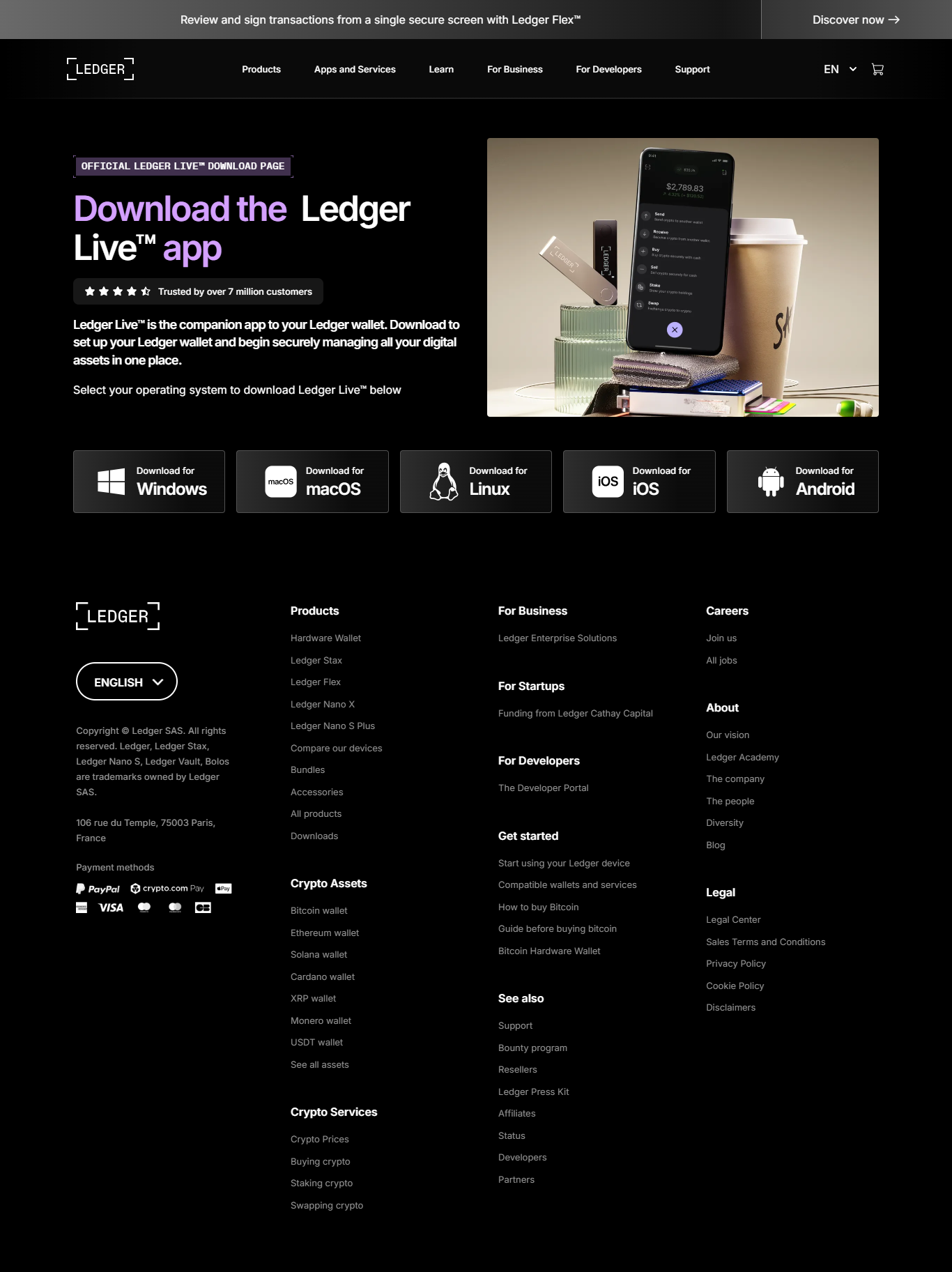Welcome to Ledger Live — your gateway to secure cryptocurrency management. Whether you're brand new to hardware wallets or looking to refresh your knowledge, this guide takes you through everything: from logging in, setting up your device, to understanding how every action keeps your assets safe.
In the realm of crypto, your private keys are everything. Ledger® Live is the interface, your Ledger device is the fortress. Here’s how they work together to protect you.
Step 1: Download & Install Ledger Live
- Go to Ledger.com/start (always verify you’re on the official site).
- Download the version suited for your platform — Desktop (Windows, macOS, Linux) or Mobile (iOS, Android).
- Install following on‑screen prompts. Accepting permissions is needed so the app can communicate with your device.
- Launch the app — you’ll see welcome screens introducing features and a setup wizard.
Step 2: Connect Your Ledger Device
Use the USB cable that came with your device (or Bluetooth if your device supports it). Make sure the device is powered on.
If using USB, ensure the cable is data‑capable (not just charging). If using Bluetooth, verify pairing codes and use official firmware so security isn’t compromised.
Step 3: Initialize or Restore
- Set up as new device: This allows you to create a brand new 24‑word recovery phrase. It’s your lifeline if anything happens to your device.
- Restore from existing phrase: If you’ve used Ledger before, recovering your accounts is possible by entering the exact words in the right order.
Never share your 24‑word recovery phrase with anyone. Ledger Support will never ask for it.
Step 4: Set Your PIN
Your device will prompt you to choose a PIN (usually 4‑8 digits). This PIN unlocks the device each time you connect it — think of it as the physical key to your safe.
Choose a PIN that is easy to remember but hard to guess. Don’t write it down where others can find it.
Step 5: Record & Secure Your Recovery Phrase
Once initialized, Ledger will display 24 words. These must be recorded exactly, in order, and stored securely.
• Use the recovery sheet provided by Ledger.
• Store in multiple safe locations (e.g. a safe at home, safety deposit box).
• Never take photos or store the phrase digitally (avoid cloud, photos, screenshots).
• If lost and device is damaged, funds are irretrievable.
Step 6: Logging In & Daily Use
- Open Ledger Live on your computer or mobile device.
- Connect your Ledger hardware wallet.
- Enter your PIN ON the device itself (never via Ledger Live app).
- Approve transactions physically on the device: checking addresses, amount, recipient, etc.
Step 7: Adding & Managing Accounts
Within Ledger Live, go to “Accounts” → “Add Account” and choose the cryptocurrency (Bitcoin, Ethereum, etc.). Ledger device installs the required “app” for each chain, enabling secure operations.
You can also track your portfolio, see historical transactions, and monitor balance changes right from Ledger Live.
Step 8: Sending & Receiving Crypto
- Receive: In Ledger Live → Receive → select account. Verify the address shown on app matches what the device displays.
- Send: Enter recipient, amount, then confirm on device physically. Always double‑check address, network fees, etc.
Step 9: Keeping Devices & Firmware Updated
Ledger periodically publishes firmware updates and app updates. Keeping them current is critical for security.
In Ledger Live → Manager, you’ll see available updates. Connect device, follow prompts, ensure it doesn’t disconnect mid‑update.
Step 10: Security Best Practices
- Always download software and firmware only from official Ledger site.
- Only trust official Ledger apps and plugins.
- Beware phishing: check domain names, email links, unexpected popups.
- Store recovery phrase physically in safe locations.
- Never share your PIN or recovery phrase.
- When connecting to third‑party services (wallet interfaces, DeFi), always use hardware wallet signing and verify addresses on device.
Common Issues & Troubleshooting
Device Not Detected
Solution tips:
- Use a different USB cable or try a different port.
- Ensure the device is unlocked (enter PIN) and showing dashboard.
- Restart your computer or phone, and try again.
Forgot PIN or Device Locked
If you enter wrong PIN too many times, the device resets. You will lose data on device—but can restore everything using recovery phrase.
Recovery Phrase Lost or Damaged
Without the exact phrase, funds are inaccessible. That’s why backups are crucial. Consider using metal backup tools for durability.
Software Refuses to Open / Errors
Possible reasons & fixes:
- Outdated OS / incompatible drivers.
- Old version of Ledger Live‑update it from official site.
- Conflict with other software—try safe mode or close other apps.
Why Ledger Live + Ledger Device is the Secure Choice
When you use Ledger Live, *your private keys never leave the device*. The app is a “view & control” surface. All critical operations—like signing a transaction—happen on the device. If malware infects your computer, it cannot extract your private keys.
Ledger Live also gives you transparency: you see addresses, balances, transaction history. Device confirms each transaction—you can verify amount & recipient on the screen. No “blind signing.”
Putting security first means understanding these basics. Once you internalize them, using Ledger Live becomes intuitive and safe.
Summary & Next Steps
Here’s a quick checklist you should complete to ensure you’ve got a solid start:
- Downloaded Ledger Live from ledger.com/start
- Initialized device & set up new device (or restored safely)
- Set PIN & recorded recovery phrase
- Added crypto accounts & tested sending/receiving
- Updated all firmware & apps
- Reviewed security practices & backups
Once you’re comfortable, explore advanced features like staking, NFT support, DeFi integrations, or using Ledger with multiple devices. But always, always prioritize safety.
Start with Ledger.com/start